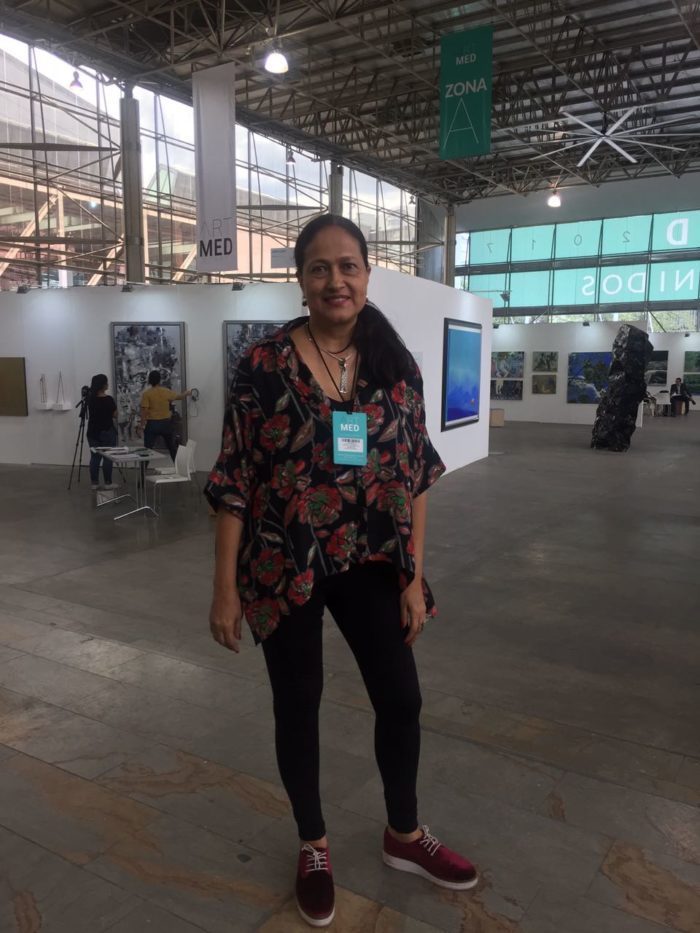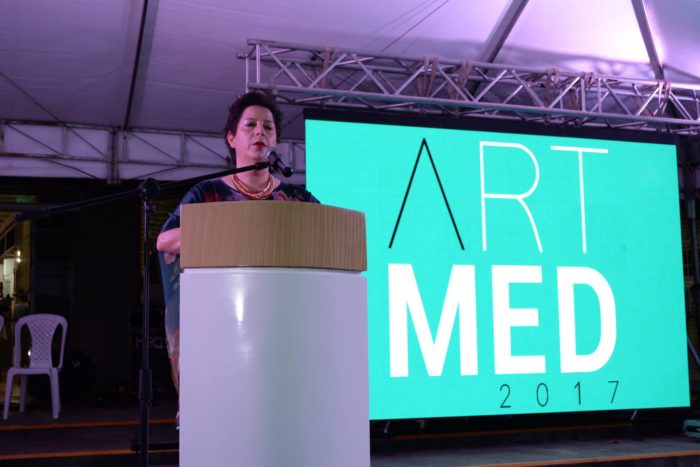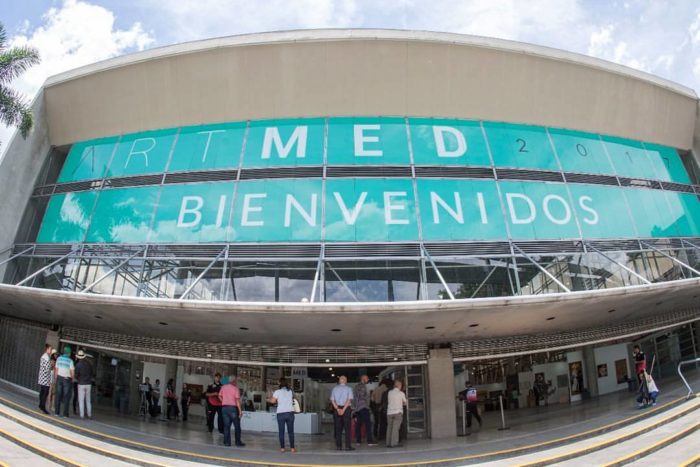Clara Mónica Zapata, Liliana Hernández Obando, Editorial Terremoto, Emiliano Valdés
Reading time: 12 minutes

27.08.2017
By Terremoto, Medellín, Colombia
August 24, 2017 – August 27, 2017

Clara Mónica Zapata
General Coordinator of ARTMED, Medellín
https://www.artmed.com.co/
Terremoto: How does ARTMED and its vision work as a platform for the development of the art market in Medellín?
Clara Mónica Zapata: ARTMED was born from the integration of a team of investors who decided to buy this project from their previous owners. And in turn we are summoned to a team of professionals so that we accompany them, in the part of address, in curatorship, to give him the structure that requires. When we do the analysis of what was the antecedent, the other versions, we found that although there was a good intentionality there was a very fragile structure of the project, and we decided then to constitute a model of development proper to the strategy, thinking that rather than being a fair And a particular event we had to develop a line of processes that integrated some previous developments, some developments in the present and some future developments to be able to legitimize, not only the fundamental act of the fair as a very strategic moment, but the relations with the creators, with the galleries, with the universities, and in a very specific way, with the buyers, with the potential consumers of the product. In that perspective, we defined that ARTMED should be a platform for the development of the visual and plastic arts of the city and the region, in dialogue with the world where in each process and in each phase we will be integrating new sectors to give you somehow that structure, as a kind of ecosystem that allows this project to be sustainable and sustainable.

T: As an emerging art fair, what are the challenges that ARTMED faces in relation to other fairs in the region such as ARTBO, Art Lima, PARC, or even arteBA?
CMZ: First of all, I would dare to say that Medellin is a city that has a very particular dynamic, in what one can define as its cultural and identity structure. The fundamental challenge is, on the one hand, to recognize the artists of the local generations, who are particularly important artists nationally and internationally, and the city does not know them. The city does not know that it has artists from many generations, from big generations and new generation artists that today are part of international collections that are even in the auctions, at the fairs, in meetings, in Europe, in New York … Then, Let’s say the great challenge is to make a recognition and generate the platform to make us aware, to tell the city that there are artists who produce and are connecting with the rest of the world. Likewise, the challenge is to integrate the art circuits with the galleries, the exhibition spaces, the workshops, the co-working, that today are enough and that are disconnected. And on the other hand, continue to stimulate collecting, because it seems that in Medellin did not exist, but it does exist. What happens is that a scenario like this has not been generated, where collectors really come and find where to consume, and they are going to consume other parts, they are going to buy art in Bogota, arteBA, Art Lima … And no Is that we want them not to go there, we want them to keep going but also buy here. And on the other hand, encourage the young collecting, let people see that this is a close matter, that art is also a matter of cultural law, democratization, and that there are ranges of values in works of art where there is for all .
T: What are the challenges facing the Latin American art market?
CMZ: I think there is a key issue. This afternoon we will have a conversation panel where we will talk about this, because there is the director of Art Lima. And the question is: will the challenge be that there is a more articulated work between the fairs, that there is a great network between fairs? And that this issue of who buys who, or who capitalizes the databases, is what is really making it possible for this to develop or do we have to do a redesign of this circuit too? So that we can then speak of a general plan of circulation of the visual and visual arts.

Liliana Hernández Obando
Artistic Director of ARTMED, Medellín
https://www.artmed.com.co/
Terremoto: Could you talk a little about the curatorial axes that articulate the artistic direction of ARTMED and, in turn, what is your vision in the long term?
Liliana Hernández Obando: ARTMED has as curatorial axis an inclusive system within the panorama of the plastic arts, especially in Colombia and in Latin America. How is this curatorial axis developed? Within the framework of a fair, one must assume a fair as an alternative space, speaking of alternations and parallels, where different art trends converge in that same space, and that chronological line of art trends that meet in a systemic way, harmonious and fair in this fairground.
When we speak of a chronological line, we can not deny that art has developed in its own time. Here at ARTMED we have that line represented in modernist galleries, they are galleries that have their identity and have built their own representation in the middle. There are also galleries at this time that are very eclectic, where they share modern and postmodern artists, as well as contemporaries. And galleries that have been founded two years ago, which we call emerging or intermediate, that are profiled in means of expression much more contemporary and much more alternative.
It also accompanies that content of the galleries a section that is important for the legitimation and validation of the curatorial action by itself, in congruence with the work of the artist, that is what we call here the Solo Projects, which are a series of Individual exhibitions of artists, artists who are endorsed by curator or gallery, showing him in this mode of assembly, spatiality and concept how important the link between curatorial work and the work of a gallery is important. The fairs are like this, are provisions that begin to create a number of relationships, networking, within the market and circulation, projection of the work, plus specific projects with this curatorial axis. Medellín has been a very important place in the graph, here are great teachers of the graph, developed from the 60s onwards. In a moment it fell and suddenly there was a displacement with the contemporary art, very informal forms of making art. The idea within the curatorial axis that we have is to begin to highlight and claim the graphic, so at the beginning of the fair we have a graphic stand, and at the end we have workshops of teachers of the local regional chart and young artists who are Beginning to recover these means of character of craft, artisan, but also artistic as concept. This is accompanied by the presence of museums, we can not avoid this institutional sphere. And on the other hand, we have the presence of publications and magazines related to art.

T: In your opinion, what is the role of curatorial practice in relation to the art market and what are its limits and potentialities?
LHO: In the first place, the curatorial issue is a mediating action, but the mediation action has to be fed by other dimensions of the curatorial. A curator does not necessarily have to stay in the processes of analysis, reflection, that mediation of the creative product of the artist towards the public. That dimension of the curatorial has to exist, as must the classical concept of the curatorial as a professional element, or a professional who preserves a certain collection. According to the current logics of the market, the circulation of the work of art, the legitimation of it through the fairs, the biennials, through the gallery, the auctions, is to understand that the curator in that mediation Academic and intellectual must also understand that there are other links that he should try to connect. When talking about, for example, public-private partnerships … this is a public-private alliance, because we are endorsed by private companies and also by government institutions and institutions. That is when the curatorial work must understand the logic of the public and the private, or the logic of the third sector, which are foundations, NGOs, nonprofit projects. So when a curator not only assumes his role as a seller of works of art, as a critic or as an ally of the artist, but understands that these types of scenarios must be kept in harmony, that is when curatorial work is enriched and It becomes a process of cultural management specifically in plastic and visual art projects linked to symbolic and real spaces, public, private and social.
T: What are the challenges facing the Latin American art market?
LHO: It can not even be said to be Latin American. That is to say, we in Latin America feel the collapse of the good or bad American economy, our part of the continent depends a lot on the exogenous economy, which is really the global economy, is the one that directs us. And that transferred to the artistic scene causes the Latin American market to fluctuate, but at the same time that fluctuation of the art goes through good times, and other times it decays. In that line of rise and fall a space of sustainability is created because when, for example, the artist has no representation of a gallery, or the gallery feels the downfall of the economy, it is the opportunity of reinvention, that is when I speak of Sustainability. Thus, art in general is a very vulnerable system to that, it even has some psychological components and of the artist’s empowerment, and of not believing that one can survive or live very well of his own art. That makes the market rise or fall. But I think it’s a system that will not change, it’s the characteristic of art in Latin America. The fact of reinventing the artist, the gallery, a system through alternative spaces, co-working … that’s what is strengthening the support.

Emiliano Valdés
Curator of MAMM
http://elmamm.org/
Terremoto: In the context of contemporary Colombian art, specifically in Medellín, what are the historical and contextual references that an international art fair should contemplate in order to be part of the circuit of art fairs in the region such as ArtBo, Odeón, ArtLima, PARC , ArteBA or even ArtRío?
Emiliano Valdés: I think the first thing is to be clear about the circuit within which you want to work. In that sense, it seems to me that professionalization is the first step to create an international fair that can work and I feel that the first step has already taken place. In Medellín, I understand that it has been committed to move from a very local event and with particular dynamics to more standard work modes, in line with global practices. There is always a lot to do in that sense but I think it is going the right way.
The following is to understand what are the specific characteristics that can make an event in Medellín a successful initiative, something that differentiates it from other fairs and events in the region. This is not clear if it is to work with a particular technique (a video or engraving fair, to give an example), if it is addressed to a specific audience (the Colombian market, Andean, etc.) and if there are other parameters that Can consolidate a fair as a reference event, as it could be a very well curated fair or a fair that specializes in artists of a certain type. That is precisely the task of management.
It seems to me that the references are precisely the market within which one wants to operate and what it offers and what does not. I see a fair in Medellín a huge challenge because there is little collecting and to attract a wider audience is going to need a hook, something that other fairs do not have. Making a fair more I think is not enough. We live in the era of specialization and I think it is something that the market demands, even at this level.
T: What are the challenges faced by contemporary art galleries in Medellín in order to develop a critical collection that is far from their past relationship with drug trafficking?
EV: I assume that with ‘critical collecting’ you mean an exercise that involves not only buying but knowing what to buy, getting involved with artists, being part of a medium and, moreover, a professional medium of contemporary art.
The challenges are multiple and some of them are deeply rooted in Antioquian culture as the well-known awareness of spending. For this, it is necessary to generate circumstances in which the public understands art as a good whose value, at bottom, is higher than its price. This requires an effort not only from the market but from many other actors, it requires working in art and culture as a social value. Part of it is already being done, hopefully it can affect the way people understand buying art.
Obviously, overcoming certain market practices also requires an impeccable ethic: managing everything in an absolutely transparent way, eradicating something that in our context is very common is the conflict of interests, and again strengthen the professionalization. If you choose a line of work and stick to it, you avoid the slippery terrain where you are a judge and part, for example.
Perhaps one way to approach that is to concentrate on a young market of new collectors who, on the one hand, do not associate the practice of buying art with drug trafficking practices and, on the other, that renew that market from the base, little by little , Building a new culture of business relationship with art. This might be a gamble, but again, I think what’s important is to understand the character that sets a fair apart from its competitors in the market.
Comments
There are no coments available.